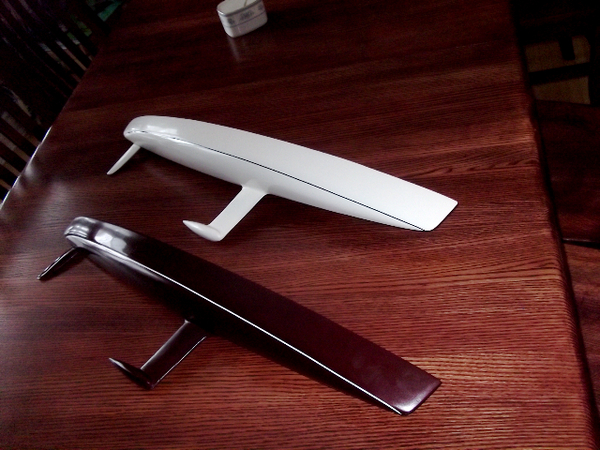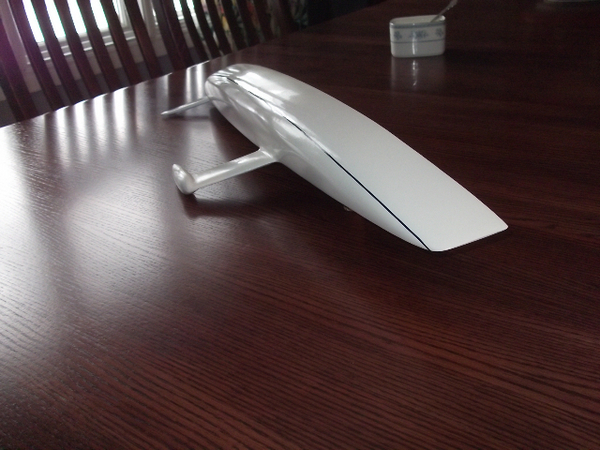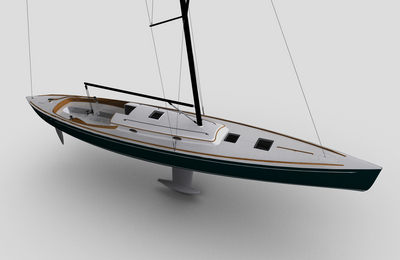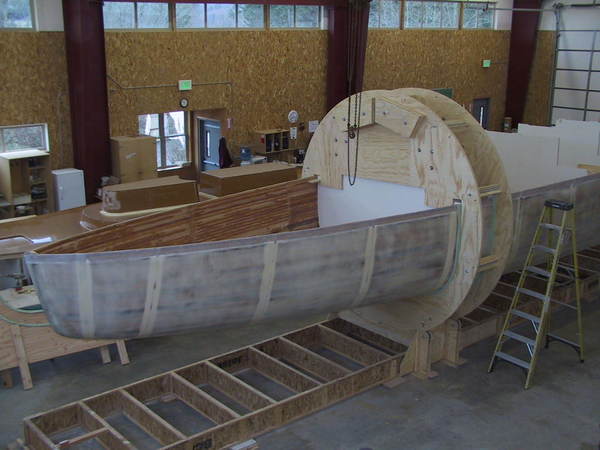Found this incredible local boat on Craigslist while home on spring break...too bad I chose to fly and not drive out here.
Ahoy... you are viewing an authentic 19' Sailing Sea Bright Beach Skiff, which is a lengthened version of Hankins traditional 16' skiff and is understood to be the last in existence that is family owned and/or known to privately exist solely.
Built in the winter of 1970 by Jersey legend Charles E. Hankins at his family's Lavallette, New Jersey boat building firm, Charles Hankins and Sons. His father, Charles M. Hankins, established the boat building business in 1912. All together, the Hankins family boat building business produced award winning Jersey Sea Skiffs and other small crafts for almost a century.

Building Specifics:
- L.O.A. - 19' (Not including rudder.)
- The Stem and Stern post are each of one piece Natural Crook White Oak.
- The Breast Hook, Transom Knees, Thwart Braces and Crooks are made from tough, durable Hackmatack, also called tamarack or American larch.
- The Rub rails, Cap, Sheer Clamp are Single Length White Oak.
- All Planks are 5/8" White Cedar.
- Ribs are ¾" x 1-1/4" on 8" Centers of 2 Planks 23" at its maximum width and is made up with ½" x 1/8" Spline.
- The Transom is from the same Stock and the Joints are Splined.
- Knowing that Cedar is tender on grounding, a Full Length Shoe 1" x 6" Oak tapering on Both Ends is fared to the Forefoot and Stern Post and Copper Riveted to the Hull.
- Being 6" in the way of the Centerboard Slot, each side offers a good bed for the Heads of the Bronze Carriage Bolts, which are run up and secure Trunk Logs.
- Water Line Length is 16' 7" / Beam at Sheer is 6" / Beam at Water Line is 4' 10".
- Freeboard Forward is 30", least 19" / Stern is 22"
- Draft of Hull forward is 3", maximum of center of lateral resistance 10", ft at Stern Post is 8", Deck Sheer is 7" and Bottom Rocker is 3".
- Rake of Transom is 30 Degrees.
- Centerboard Construction: Lumber was selected for proper grain to minimize warping of 1-1/8" X 5" White Oak Planks Doweled with 3/8" Bronze Rods.
- The Rudder Hangs by 3 Sets of Bronze Gudgeons, which receive a 5/8" Bronze Rod that serves as a Common Pin. This allows the Rudder, which has 4" more draft than the Hull to slide up the Pin when Grounding/Beaching.
- Sail Area: 141 Square Feet, Jib is 30 Square Feet, Main is 11 Square Feet.
- All Spars are Sitka Spruce; Mast is 15'-6" in Length x 3-1/2" at its maximum in Diameter and Tapering to 2-1/4" at the Head.
- Sprit is 16'- 6" x 2-1/8" at its maximum Diameter tapering to 1-¼" at each end.
Antique Hand Bilge Pump is included.

Auxiliary Power: Fitted with a Stainless Steel Bracket to hold a "Show Quality" small British Silver Seagull 12-hp. 2-Stroke Outboard Motor, but truly being an easily steered hull, a Zephyr is all that is needed to give her way.
Trailer: (Show/Competition Quality) 1974 Holsclaw Double Axle renovated trailer. New axle hubs, back plates, master/wheel brake cylinder(s), new wheel bearings, with high pressure wheel bearing grease, new rear tail-lights, 5 new tires and 5 new O.E.M. Holsclaw half-moon chrome hub caps.
Mooring Cover: High-quality "Marine Blue" heavy duty custom mooring cover, with Velcro ring-slit for leaving mast up. New in 2013 and used only 3 months ever...
All copies of original build documents, Bill of Sales and written correspondence between original owner, legendary designer John Gardner and boatbuilder Charles E. Hankins are in good legible state.
Owner's manual for British Silver Seagull outboard engine is included.
The original trace paper-full rudder pattern and copies of early photos of the skiff being built, plus the day of completion are complete. Detailed build drawings and a fresh scanned color copy of National Fisherman's, October 1973 - 2 page write-up by Technical Editor-John Gardner are also included.
Video of a skiff being built by Charles Hankins and the history of the Sea Bright Skiff can be viewed on the web at:
www.folkstreams.net/film,41 Click on Sea Bright Skiff. Our skiff was built in the same shop and in the exact manner filmed.
A Copyrighted CD of the film is in hand for a Kiosk Video Screen and can run as a film loop or play-on-demand for public display/viewing.
.jpg)
This past autumn our Hankins 19' Sailing Sea Bright Beach Skiff was entered on display at the 32nd Annual Mid-Atlantic Small Craft Festival on Oct. 3rd-5th, 2014 at the Chesapeake Bay Maritime Museum in St. Michaels, Maryland.
Our family was honored to have received SECOND PLACE in the Restoration Judging Category and Scoring Criteria, which the following is explained:
Restoration: Boats are judged on their importance in preserving our nautical heritage and on the extent of the work done to the boat.
1. Design -
a. Pre-WW II and rare 20, b. Pre-WW II, but more common 15, c. Post-WW II and rare 10 and d. Post-WW II, but more common 5.
2. Degree of difficulty -
a. Major restoration (bringing 'em back to life) 30 and b. Mostly minor repairs and cosmetics 10
3. Presentation -
a. Documentation (pictures, drawings, etc.) 10 and b. Tools displayed 10
4. Overall execution of the boat and its display: 25 - 40 *
* The scoring for "overall execution of the boat and its display" includes construction quality, project photos, clarity of presentation, and attention to detail. Possible scores are: Outstanding -- 40, Excellent -- 35, Good -- 30 and Average -- 25
Participants from all over the USA attend the 3 day festival. Competition was abound!
Charles E. Hankins would have been proud none the less...
The Maryland Dept. of Natural Resources title for the skiff and Motor Vehicle Administration title on the classic boat trailer are clear and in hand.

FOR SALE: $15k O.B.O
to the next steward(s), who will treasure, protect and gingerly use her with passion as we have!
Call:
show contact info - Spring 2015
If you are only interested in purchasing the skiff without the British Silver Seagull Outboard ($500.00) and/or the 1974 period Holsclaw Double Axle custom-fit complete renovated trailer ($1,500.00) a fair price reduction of $2k will be honored for both.
Will offer negotiating mileage/tolls to personally transport skiff safely to the new owner(s)...
NOTE: Our family has chosen not to donate this museum quality original Hankins Sea Bright Beach Skiff to any non-profit, government or public organization(s), so please do not inquire or communicate anymore to persuade otherwise.

Charles E. Hankins was born on August 27, 1925, and raised along the New Jersey shore. At an early age, he started helping his father, Charles M. Hankins, in his boatyard to make Sea Bright skiffs, a type of wooden boat well suited for the coastal area where they lived. Initially, he was able to do only small tasks, but he watched closely as his father worked. Charles built his first boat when he was about 15 years old. During World War II, he left the boat shop for three years to serve in the United States Coast Guard. When he was discharged, he returned to work with his father and older brother, James.
The Sea Bright Skiff was first built in the 1830s in the area known as Sea Bright, just below Fort Hancock in Monmouth County on the Jersey shore, where there were no inlets of calm water and boats had to be launched directly off the beach into pounding surf. Fishing was vital to the livelihood of local communities, as were lifesaving capabilities in a region where shipwrecks were common. In response to these needs, local boatbuilders applied their time-honored skills to the creation of a new type of boat. Its flat bottom with curved rocker and rounded or "sheer" sides let it skid over the sand and turn easily instead of upsetting. Its slanting stern allows the waves to go under rather than into the boat when it is being taken ashore, and its relatively light weight and flexibility made it unlike any other boat in the world.
Over time, the boat became so admired and so associated with the town where it was created that it took the Sea Bright name. Although the Sea Bright skiff has been fine-tuned by several generations of boatbuilders to fit changing local needs, from fishing to rum-running during Prohibition to lifesaving today, its basic form has remained the same.
Hankins's father worked for several years with Charles Huff, a noted boatbuilder around the turn of the twentieth century. In 1912, the elder Hankins established his own business and created an identity as a boatbuilder to meet the needs of his clientele. Although fishermen utilized 33-foot skiffs to get out beyond the breaking waves and set nets, rum-runners preferred 28-foot skiffs outfitted with surplus airplane engines from World War I. Hankins said that his family sometimes built pursuit boats for the Coast Guard so that they were able to chase and get up alongside the rum-runners.
Hankins's father began supplying the Lifeguard Service with these skiffs in the 1920s. For lifeguards, Hankins said, the boat needed to be smaller to facilitate greater maneuverability in their efforts to control crowds, patrol for sharks and debris, and sometimes pick up shipwreck victims. The boats are also used for lifeguard training, drills, and competitive tournaments.
Since the deaths of both his father and his brother, Hankins has taken over the family business. With the help of a full-time assistant, he spends two weeks making each skiff. Over the years, he made some subtle but important changes to the skiff's design to meet the changing needs of lifeguards. He designed a longer boat to produce more "glide" in lifeguard tournaments. His Sea Bright skiffs are 18 feet long, one foot longer than the boats made by his father. He also designed a special "competition" oarlock that is less dangerous than the horseshoe prongs of the older oarlocks. Other features of the boat's design remain unchanged.
The average life of a Sea Bright Skiff is 20 years. On occasion, the boats find extended life beyond the ocean: for example, a restaurant in Point Pleasant uses a skiff for its salad bar. Hankins's reputation as a boatbuilder has grown considerably; he has received orders from Rhode Island, Nantucket, Long Island, and as far away as Maryland, Florida, Alaska, the Bahamas, Europe, South America, and Greenland. Hankins has made more than a thousand boats since 1945. Two Hankins boats (one by him and the other by his father) are on permanent display at the Mystic Seaport Museum in Connecticut.
This particular 19' Sea Bright Beach Skiff was on display in New Jersey for years at the Toms River Seaport Society & Maritime Museum. Beyond rare. . . Again, it is the last known true Hankins heirloom of this style that is personally owned. It was soaked, swelled and sailed during the summer of 2014, prior to that, it had been stored indoors for years on display and while it was refurbished.
In 1993 Charlie was invited to Washington, D.C. to build a lifeboat for the Smithsonian Folklife Festival. At that time, he received the National Endowment for the Arts Award. On Junes 24th, 2003 Charles E. Hankins passed away.




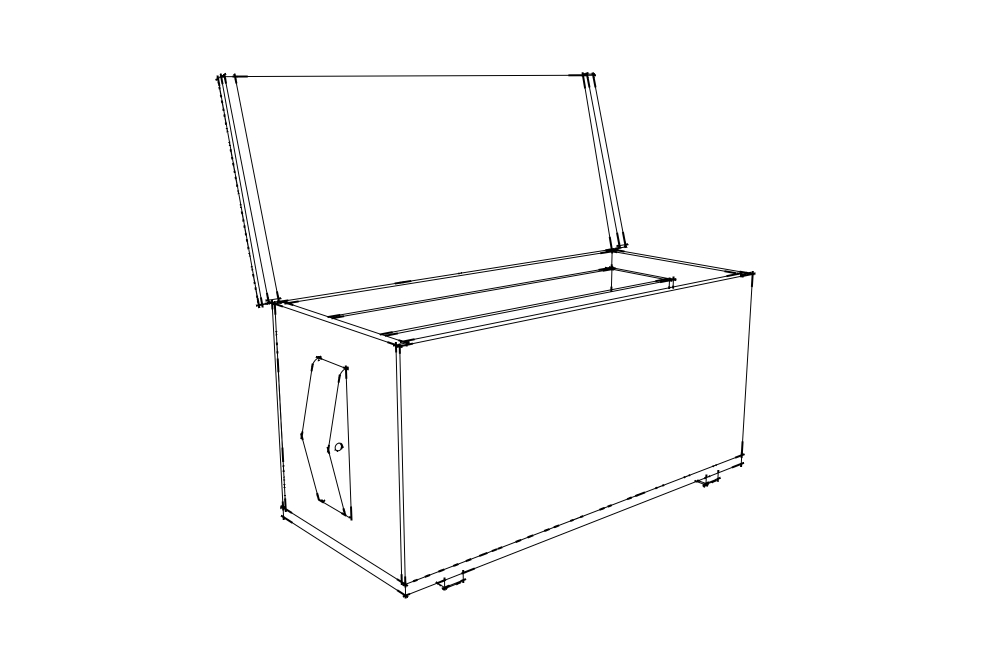
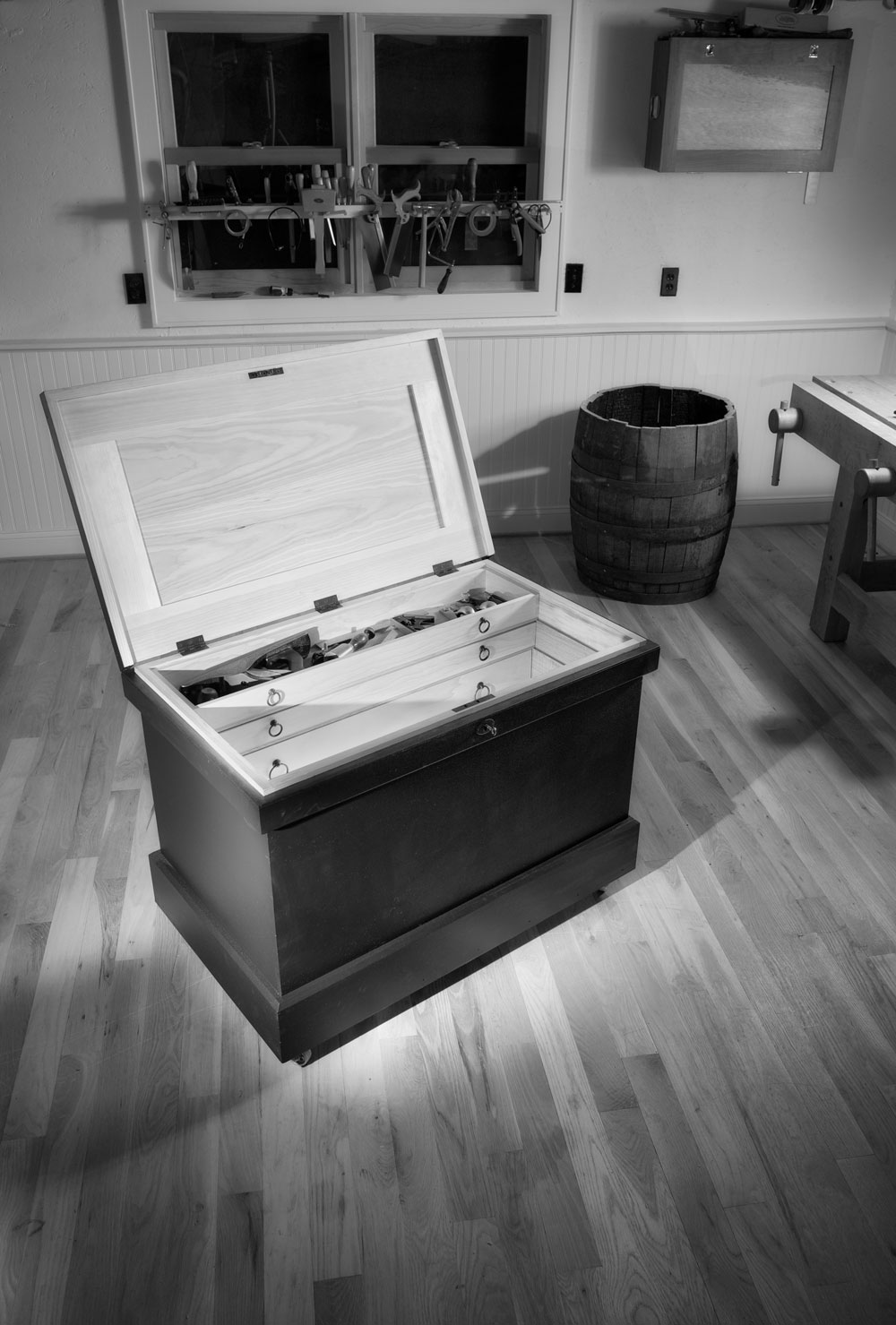
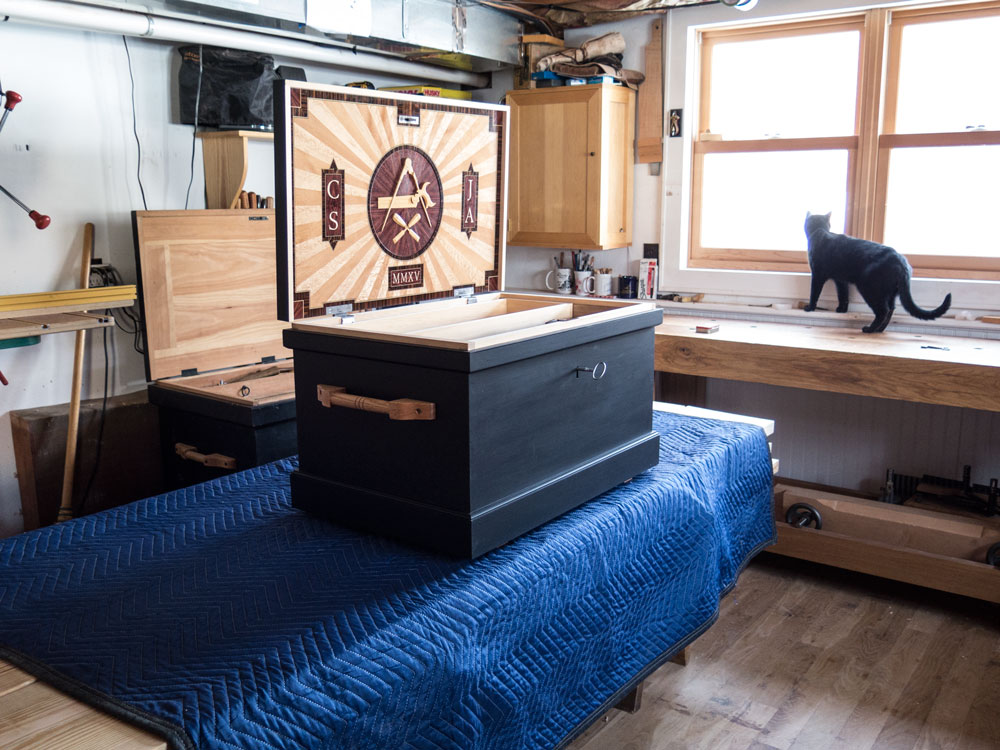
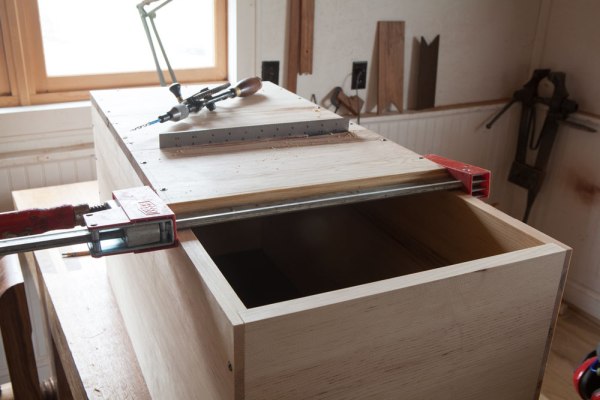







.jpg)




